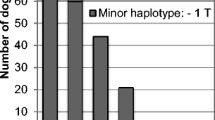Abstract
Artificial mummification was practised in Egypt from ∼ 2600 BC until the fourth century AD. Because of the dry Egyptian climate, however, there are also many natural mummies preserved from earlier as well as later times. To elucidate whether this unique source of ancient human remains can be used for molecular genetic analyses, 23 mummies were investigated for DNA content. One 2,400-yr-old mummy of a child was found to contain DNA that could be molecularly cloned in a plasmid vector. I report here that one such clone contains two members of the Alu family of human repetitive DNA sequences, as detected by DNA hybridizations and nucleotide sequencing. These analyses show that substantial pieces of mummy DNA (3.4 kilobases) can be cloned and that the DNA fragments seem to contain little or no modifications introduced postmortem.
Similar content being viewed by others
References
Sandison, A. T. Stain Technol. 30, 277–283 (1955).
Pääbo, S. Das Altertum 30, 213–218 (1984).
Pääbo, S. J. archaeol. Sci. (submitted).
Possnert, G. Nucl. Instrum. Meth. Phys. Res. B5, 159–161 (1984).
Graham, D. E. Analyt. Biochem. 85, 609–613 (1978).
Vieira, J. & Messing, J. Gene 19, 259–268 (1982).
Rigby, P. W. J., Dieckmann, M., Rhodes, C. & Berg, P. J. molec. Biol. 113, 237–251 (1977).
Schmid, C. W. & Jelinek, W. R. Science 216, 1065–1070 (1982).
Southern, E. M. J. molec. Biol. 98, 504–517 (1975).
Deininger, P. L., Jolly, D. J., Rubin, C. M., Friedmann, T. & Schmid, C. W. J. molec. Biol. 151, 17–33 (1981).
Barker, W. C. et al. Nucleic Acid Sequence Database Version 22, National Biomedical Research Foundation (Washington, DC, 1984).
Daniels, F. Jr & Post, P. W. Adv. Biol. Skin 10, 279–292 (1970).
Chapel, T. A., Mehregan, A. H. & Reyman, T. A. J. Am. Acad. Derm. 4, 27–30 (1981).
Lucas, A. J. Egyptol. Archaeol. 18, 125–140 (1932).
Higuchi, R., Bowman, B., Freiberger, M., Ryder, O. A. & Wilson, A. C. Nature 312, 282–284 (1984).
Trigger, B. G. The Cambridge History of Africa (eds Fage, J. D. & Oliver, R.) 478–547 (Cambridge University Press, 1982).
Harrison, R. G., Connolly, R. C. & Abdalla, A. Nature 224, 325–326 (1969).
Reeves, C. N. Göttinger Miszellen 54, 61–71 (1982).
Harris, J. E. et al. Science 200, 1149–1151 (1978).
Gerger, J. P., Stern, R. H. & Wensink, P. C. Nucleic Acids Res. 7, 2115–2136 (1979).
Larhammar, D., Servenius, B., Rask, L. & Peterson, P. A. Proc. natn. Acad. Sci. U.S.A. (in the press).
Maxam, A. M. & Gilbert, W. Meth. Enzym. 65, 499–560 (1980).
Author information
Authors and Affiliations
Rights and permissions
About this article
Cite this article
Pääbo, S. Molecular cloning of Ancient Egyptian mummy DNA. Nature 314, 644–645 (1985). https://doi.org/10.1038/314644a0
Received:
Accepted:
Issue Date:
DOI: https://doi.org/10.1038/314644a0
- Springer Nature Limited
This article is cited by
-
Ancient DNA: the past for the future
BMC Genomics (2023)
-
From Neanderthal genome to Nobel prize: meet geneticist Svante Pääbo
Nature (2022)
-
The elusive parasite: comparing macroscopic, immunological, and genomic approaches to identifying malaria in human skeletal remains from Sayala, Egypt (third to sixth centuries AD)
Archaeological and Anthropological Sciences (2021)





